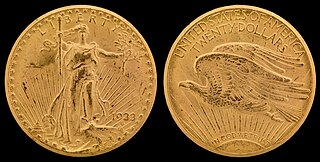 W
WThe 1933 double eagle is a United States 20-dollar gold coin. Although 445,500 specimens of this Saint-Gaudens double eagle were minted in 1933, none were ever officially circulated, and all but two were ordered to be melted down. However, 20 more are known to have been rescued from melting by being stolen and found their way into the hands of collectors before later being recovered. Nine of the recovered coins were destroyed, making this one of the world's rarest coins, with only 13 known specimens remaining—only one of which is privately owned.
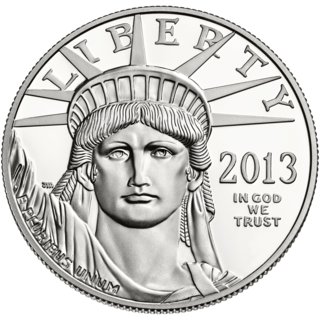 W
WThe American Platinum Eagle is the official platinum bullion coin of the United States. In 1995, Director of the United States Mint Philip N. Diehl, American Numismatic Association President David L. Ganz, and Platinum Guild International Executive Director Jacques Luben began the legislative process of creating the Platinum Eagle. After over two years of work, the 99.95% fine platinum coins were released by the United States Mint in 1⁄10, 1⁄4, 1⁄2 and 1 troy oz denominations. In late 2008, the fractional denominations were discontinued, leaving only the one ounce denomination. The Platinum Eagle is authorized by the United States Congress, and is backed by the United States Mint for weight, content, and purity.
 W
WThe American Silver Eagle is the official silver bullion coin of the United States.
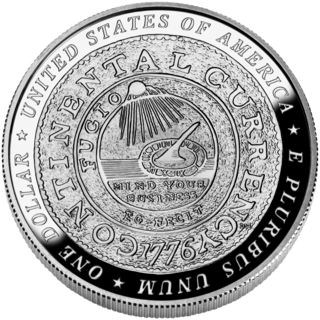 W
WThe Benjamin Franklin silver dollar is a commemorative coin issued by the United States Mint in 2006.
 W
WThe Brasher Doubloon is a rare American coin, privately minted in and after 1787.
 W
WThe Continental Currency dollar coin was the first pattern coin struck for the United States. The coins were minted in 1776 and examples were made on pewter, brass, and silver planchets.
 W
WThe Daniel Boone Bicentennial half dollar was designed by Henry Augustus Lukeman and minted during the 1934, commemorating the 200th birthday of frontiersman Daniel Boone. The obverse depicts Boone while the reverse depicts a frontiersman (Boone) standing next to an Indian Chief in front of a stockade on the left and the rising Sun on the right.
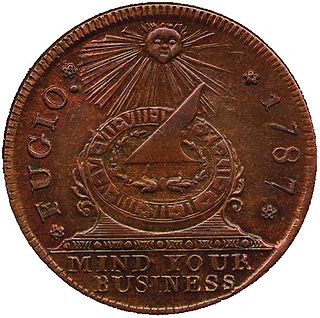 W
WThe Fugio cent, also known as the Franklin cent, is the first official circulation coin of the United States. Consisting of 0.36 oz (10 g) of copper, it was designed by Benjamin Franklin and minted only in 1787. Its design is very similar to a 1776 Continental Currency dollar coin that was produced in pattern pieces as potential Continental currency but was never circulated.
 W
WThe Illinois Centennial half dollar is a commemorative 50-cent piece struck by the United States Bureau of the Mint in 1918. The obverse, depicting Abraham Lincoln, was designed by Chief Engraver George T. Morgan; the reverse, based on the Seal of Illinois, was by his assistant and successor, John R. Sinnock. Morgan's obverse is based on the statue by Andrew O'Connor.
 W
WThe Noah's Ark silver coins are Armenian bullion coins issued since 2011. They are available in various sizes with a fine weight between 1⁄4 ounce and 5 kg in silver of 999/1000 fineness. The 1 oz. coin has a nominal value of 500 Drams and is a legal tender in Armenia. The coin is produced by the Leipziger Edelmetallverarbeitungs GmbH, an affiliated company of Geiger Edelmetalle. The motif of the coin remains constant, similar to other bullion coins such as the Canadian Silver Maple Leaf, the Vienna Philharmonic, or the American Silver Eagle.
 W
WThe Oregon Trail Memorial half dollar was a fifty-cent piece struck intermittently by the United States Bureau of the Mint between 1926 and 1939. The coin was designed by Laura Gardin Fraser and James Earle Fraser, and commemorates those who traveled the Oregon Trail and settled the Pacific Coast of the United States in the mid-19th century. Struck over a lengthy period in small numbers per year, the many varieties produced came to be considered a ripoff by coin collectors, and led to the end, for the time, of the commemorative coin series.
 W
WThe five Panama–Pacific commemorative coins were produced in connection with the 1915 Panama–Pacific International Exposition in San Francisco. Struck at that city's mint, the issue included round and octagonal $50 pieces. Excepting modern bullion coins, these two gold pieces are the highest denomination ever issued and the largest coins ever struck by the United States Mint. The octagonal $50 piece is the only U.S. coin to be issued that is not round.
 W
WThe Peace dollar is a United States dollar coin minted from 1921 to 1928, in 1934 and 1935, and as a commemorative in 2021. Designed by Anthony de Francisci, the coin was the result of a competition to find designs emblematic of peace. Its obverse represents the head and neck of the Goddess of Liberty in profile, and the reverse depicts a bald eagle at rest clutching an olive branch, with the legend "Peace". It was the last United States dollar coin to be struck for circulation in silver.
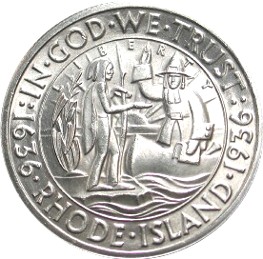 W
WThe Rhode Island Tercentenary half dollar is a commemorative fifty-cent piece struck by the United States Bureau of the Mint in 1936. The coin was designed by John Howard Benson and Arthur Graham Carey. Its obverse depicts Roger Williams, founder of the Colony of Rhode Island and Providence Plantations. It was intended to honor the 300th anniversary of Providence, Rhode Island, although it bears no mention of the city.
 W
WThe Saint-Gaudens double eagle is a twenty-dollar gold coin, or double eagle, produced by the United States Mint from 1907 to 1933. The coin is named after its designer, the sculptor Augustus Saint-Gaudens, who designed the obverse and reverse. It is considered by many to be the most beautiful of U.S. coins.
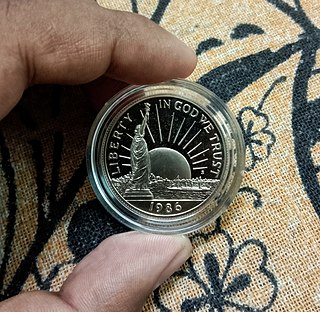 W
WThe Statue of Liberty commemorative coins are a series of commemorative coins which were issued by the United States Mint in 1986.
 W
WVermont coppers were copper coins issued by the Vermont Republic. The coins were first struck in 1785 and continued to be minted until Vermont's admission to the United States in 1791 as the State of Vermont.
 W
WThe Walking Liberty half dollar is a silver 50-cent piece or half dollar coin that was issued by the United States Mint from 1916 to 1947; it was designed by Adolph A. Weinman, a well-known sculptor and engraver.
 W
WThe York County, Maine, Tercentenary half dollar is a 50-cent commemorative coin minted in 1936 to mark the tercentenary of the founding of York County, Maine. The obverse shows Brown's Garrison, the fort around which York County was formed, while the reverse depicts the county's arms.